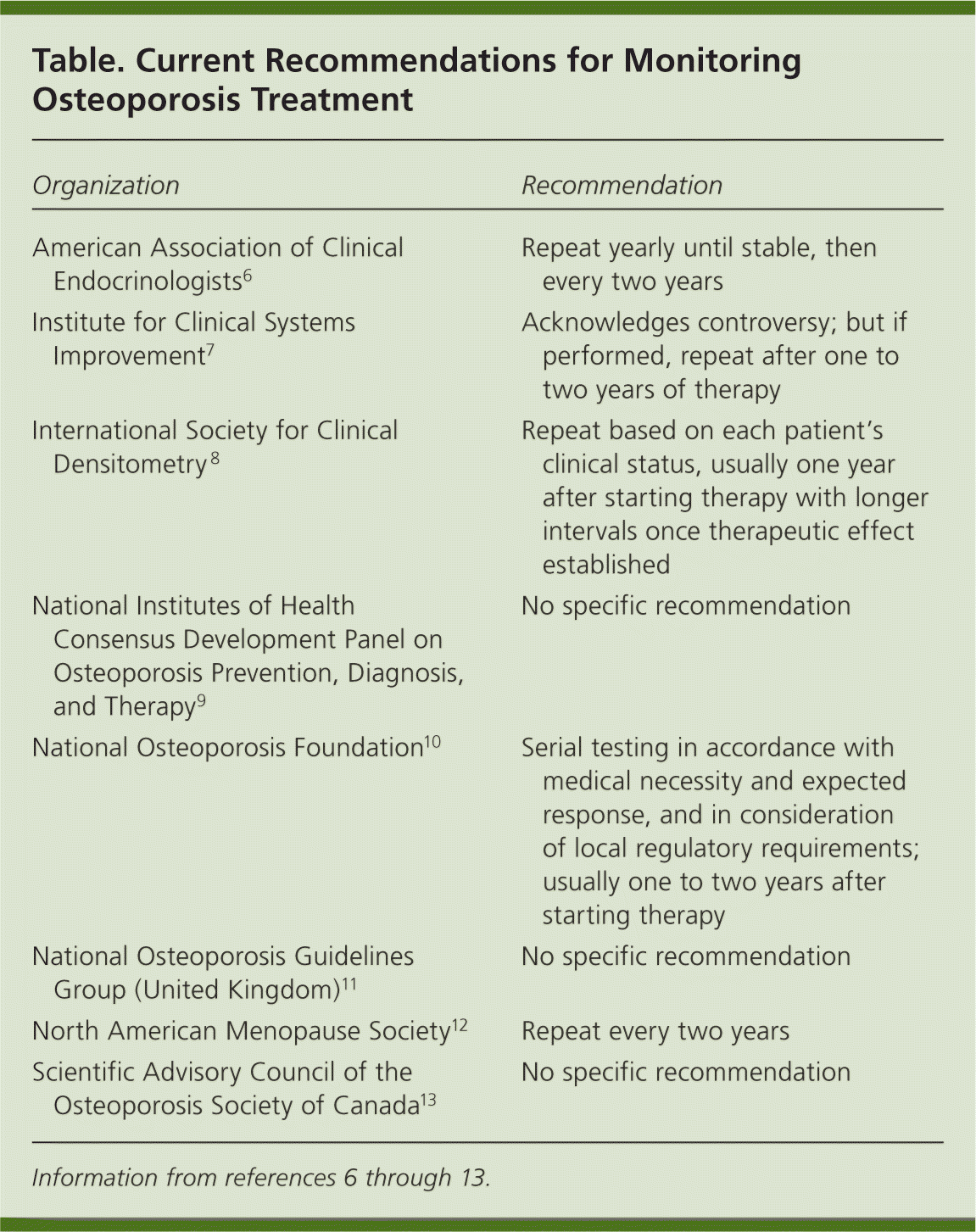
Am Fam Physician. 2010;82(7):752-754
This is one in a series of pro/con editorials discussing controversial issues in family medicine.
Initiating treatment for osteoporosis is a relatively straightforward clinical decision; however, determining if the patient has responded to treatment is a complex issue. The goal of osteoporosis treatment is reducing the patient's fracture risk.1 Bone mineral density (BMD), as measured by dual-energy x-ray absorptiometry (DXA), is used as a surrogate marker for fracture risk; however, no studies have shown whether monitoring of therapy with repeat DXA actually reduces fractures. We believe that routine DXA to monitor therapy is unnecessary and a poor use of medical resources.
Most women significantly increase their BMD with treatment. In clinical trials, less than 10 percent of treated patients had a significant decrease in BMD.2
Among women whose BMD decreases, the most common cause is medication non-compliance, especially during the first three months of therapy. Compliance can be monitored by having a medical assistant assess therapy adherence3 or by evaluating prescription refills.4 Compliance is not an issue for physician-administered intravenous therapies. The least likely explanation for a decrease in BMD is nonresponse to therapy.5
Several organizations have made opinion-based recommendations about repeating DXA (see accompanying table).6–13 A shortcoming of expert opinion guidelines is the lack of data to support the recommendations. An evidence-based report in 2001 from the Agency for Healthcare Research and Quality discouraged retesting during the first year of therapy and cited insufficient evidence to determine the necessity of ever repeating the test.14 That report has not been updated.

| Organization | Recommendation |
|---|---|
| American Association of Clinical Endocrinologists6 | Repeat yearly until stable, then every two years |
| Institute for Clinical Systems Improvement7 | Acknowledges controversy; but if performed, repeat after one to two years of therapy |
| International Society for Clinical Densitometry 8 | Repeat based on each patient's clinical status, usually one year after starting therapy with longer intervals once therapeutic effect established |
| National Institutes of Health Consensus Development Panel on Osteoporosis Prevention, Diagnosis, and Therapy9 | No specific recommendation |
| National Osteoporosis Foundation10 | Serial testing in accordance with medical necessity and expected response, and in consideration of local regulatory requirements; usually one to two years after starting therapy |
| National Osteoporosis Guidelines Group (United Kingdom)11 | No specific recommendation |
| North American Menopause Society12 | Repeat every two years |
| Scientific Advisory Council of the Osteoporosis Society of Canada13 | No specific recommendation |
Many factors affect the accuracy of BMD testing, including intermachine variance; therefore, any repeat DXA ideally should be with the same machine.15 Because all testing methods have variations in successive measurements due to random fluctuations, a statistically significant change in BMD must exceed the expected test-to-test variation. This statistically significant amount is referred to as the least significant change or the smallest detectible difference.16 However, these effects take years to develop.
When outlying, seemingly extreme measurement results are repeated, they are often closer to the mean without any change in treatment; this phenomenon is called regression to the mean. Accordingly, repeating DXA in less than two years is unlikely to be clinically useful.17,18 One study found that monitoring therapy during the first three years of bisphosphonate therapy is unnecessary and perhaps misleading.19 Longitudinal data from Canada have challenged the need to repeat DXA in less than five years.20
An increase in BMD is associated with reduced fracture risk.21,22 However, the relationship between BMD and fracture risk is not a linear one. Fracture risk decreases soon after beginning therapy, even preceding a measurable improvement in BMD.23,24 Fracture risk can decrease with no change in BMD.25 Studies have even shown a decreased fracture risk despite a slight decrease in BMD.26,27
Unless the physician knows how to adjust therapy based on repeat DXA, monitoring osteoporosis treatment via DXA is unlikely to be clinically necessary or beneficial. Currently, we assume that if the patient has not had a fracture and the BMD significantly increases, then no change in treatment is necessary. Most authorities recommend no change in treatment with a stable BMD.8 Alternatively, if the BMD significantly worsens, should the therapy be changed? Proponents of repeat testing argue that a significant decrease in BMD would alert the physician to assess for secondary causes of osteoporosis, compliance with medication, or appropriate use of weight-bearing exercise.28 All of these issues influence the treatment of osteoporosis, but most physicians can address these issues without using medical resources and repeating DXA.
Large test-to-test variance in BMD for the same person renders monitoring compliance to therapy via repeat DXA at least problematic, if not inaccurate.19 Researchers have found no evidence that repeat DXA, up to eight years later, was better at predicting fracture risk than the initial test.29 No study has addressed whether monitoring with repeat DXA improves compliance or BMD, or reduces fractures.
No outcomes-based answers are available to guide treatment changes based on repeat DXA. We urge physicians to continue osteoporosis treatment with medication and lifestyle changes, and we believe that additional routine DXA is unwarranted. Although this differs from expert guidelines, it is consistent with other published opinions.30 Some monitoring of osteoporosis treatment may be helpful in the future, but it should be targeted to at-risk populations,31 which have yet to be identified.
